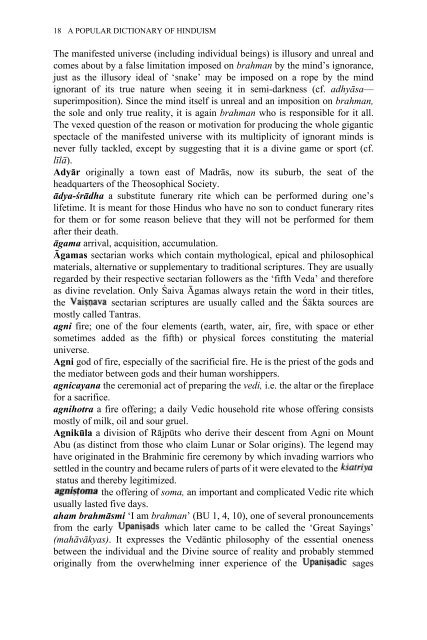Create successful ePaper yourself
Turn your PDF publications into a flip-book with our unique Google optimized e-Paper software.
18 A POPULAR DICTIONARY OF HINDUISM<br />
The manifested universe (including individual beings) is illusory and unreal and<br />
comes about by a false limitation imposed on brahman by the mind’s ignorance,<br />
just as the illusory ideal <strong>of</strong> ‘snake’ may be imposed on a rope by the mind<br />
ignorant <strong>of</strong> its true nature when seeing it in semi-darkness (cf. adhyāsa—<br />
superimposition). Since the mind itself is unreal and an imposition on brahman,<br />
the sole and only true reality, it is again brahman who is responsible for it all.<br />
The vexed question <strong>of</strong> the reason or motivation for producing the whole gigantic<br />
spectacle <strong>of</strong> the manifested universe with its multiplicity <strong>of</strong> ignorant minds is<br />
never fully tackled, except by suggesting that it is a divine game or sport (cf.<br />
līlā).<br />
Adyār originally a town east <strong>of</strong> Madrās, now its suburb, the seat <strong>of</strong> the<br />
headquarters <strong>of</strong> the Theosophical Society.<br />
ādya-śrādha a substitute funerary rite which can be performed during one’s<br />
lifetime. It is meant for those Hindus who have no son to conduct funerary rites<br />
for them or for some reason believe that they will not be performed for them<br />
after their death.<br />
āgama arrival, acquisition, accumulation.<br />
Āgamas sectarian works which contain mythological, epical and philosophical<br />
materials, alternative or supplementary to traditional scriptures. They are usually<br />
regarded by their respective sectarian followers as the ‘fifth Veda’ and therefore<br />
as divine revelation. Only Śaiva Āgamas always retain the word in their titles,<br />
the sectarian scriptures are usually called and the Śākta sources are<br />
mostly called Tantras.<br />
agni fire; one <strong>of</strong> the four elements (earth, water, air, fire, with space or ether<br />
sometimes added as the fifth) or physical forces constituting the material<br />
universe.<br />
Agni god <strong>of</strong> fire, especially <strong>of</strong> the sacrificial fire. He is the priest <strong>of</strong> the gods and<br />
the mediator between gods and their human worshippers.<br />
agnicayana the ceremonial act <strong>of</strong> preparing the vedi, i.e. the altar or the fireplace<br />
for a sacrifice.<br />
agnihotra a fire <strong>of</strong>fering; a daily Vedic household rite whose <strong>of</strong>fering consists<br />
mostly <strong>of</strong> milk, oil and sour gruel.<br />
Agnikūla a division <strong>of</strong> Rājpūts who derive their descent from Agni on Mount<br />
Abu (as distinct from those who claim Lunar or Solar origins). The legend may<br />
have originated in the Brahminic fire ceremony by which invading warriors who<br />
settled in the country and became rulers <strong>of</strong> parts <strong>of</strong> it were elevated to the<br />
status and thereby legitimized.<br />
the <strong>of</strong>fering <strong>of</strong> soma, an important and complicated Vedic rite which<br />
usually lasted five days.<br />
aham brahmāsmi ‘I am brahman’ (BU 1, 4, 10), one <strong>of</strong> several pronouncements<br />
from the early<br />
which later came to be called the ‘Great Sayings’<br />
(mahāvākyas). It expresses the Vedāntic philosophy <strong>of</strong> the essential oneness<br />
between the individual and the Divine source <strong>of</strong> reality and probably stemmed<br />
originally from the overwhelming inner experience <strong>of</strong> the<br />
sages


















